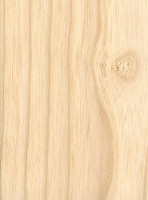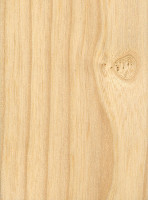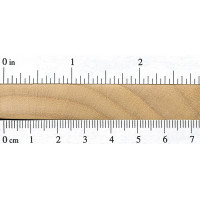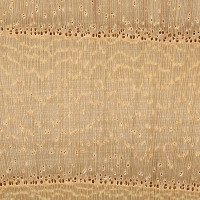 |
Common Name(s): Oregon Ash Scientific Name: Fraxinus latifolia Distribution: Western North America Tree Size: 65-80 ft (20-25 m) tall, 1-3 ft (.3-1.0 m) trunk diameter Average Dried Weight: 38 lbs/ft3 (610 kg/m3) Specific Gravity (Basic, 12% MC): .50, .61 Janka Hardness: 1,160 lbf (5,160 N) Modulus of Rupture: 12,700 lbf/in2 (87.6 MPa) Elastic Modulus: 1,360,000 lbf/in2 (9.38 GPa) Crushing Strength: 6,040 lbf/in2 (41.7 MPa) Shrinkage: Radial: 4.1%, Tangential: 8.1%, Volumetric: 13.2%, T/R Ratio: 2.0 |
Color/Appearance: The heartwood is a light to medium brown color. Sapwood can be very wide, and tends to be a beige or light brown; not always clearly or sharply demarcated from heartwood.
Grain/Texture: Has a medium to coarse texture similar to oak. The grain is almost always straight and regular, though sometimes curly or figured boards can be found.
Rot Resistance: Heartwood is rated as perishable, or only slightly durable in regard to decay. Ash is also not resistant to insect attack.
Workability: Produces good results with hand or machine tools. Responds well to steam bending. Glues, stains, and finishes well.
Odor: Gives off a distinct, moderately unpleasant smell when being worked.
Allergies/Toxicity: Ash in the Fraxinus genus has been reported to cause skin irritation, and a decrease in lung function. See the articles Wood Allergies and Toxicity and Wood Dust Safety for more information.
Pricing/Availability: Ash is among the least expensive utility hardwoods available domestically; it should compare similarly to oak in terms of price.
Sustainability: This wood species is not listed in the CITES Appendices or on the IUCN Red List of Threatened Species.
Common Uses: Flooring, millwork, boxes/crates, baseball bats, and other turned objects such as tool handles.
Comments: Oregon Ash is one of a handful of species in the Fraxinus genus that are used as commercial lumber. It’s not quite as strong or dense as the related White Ash (Fraxinus americana).
When stained, ash can look very similar to oak (Quercus spp.), although oaks have much wider rays, which are visible on all wood surfaces—even on flatsawn surfaces, where they appear as short, thin brown lines between the growth rings. Ashes lack these conspicuous rays.








Would Oregon Ash be the best indigenous Western (from continental divide to Pacific coast) wood for tool handle applications such as hammers and axes?
Would Pacific Yew be an acceptable alternative?